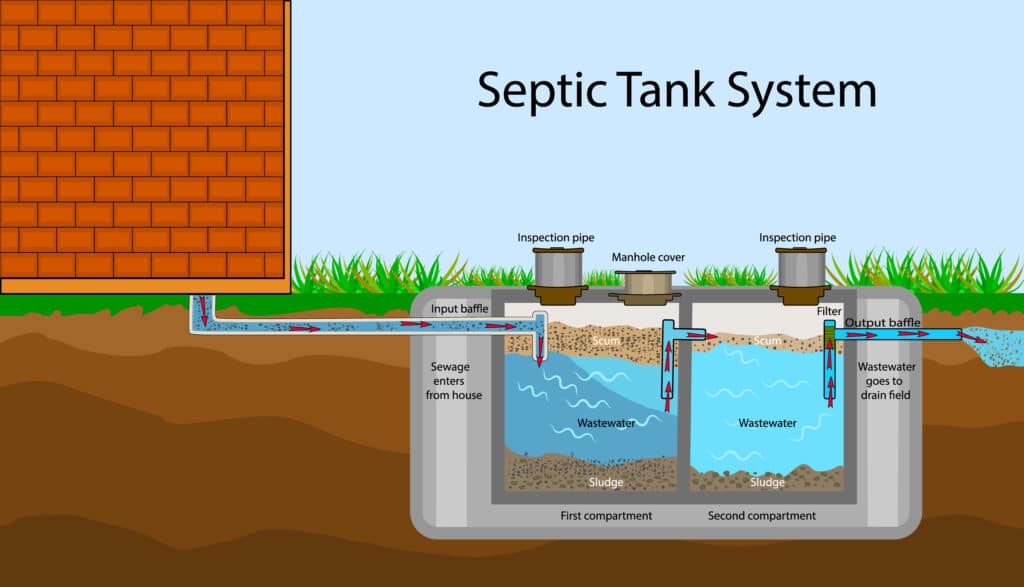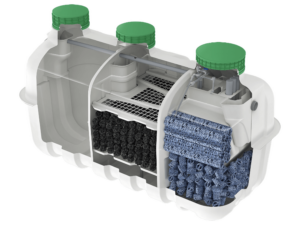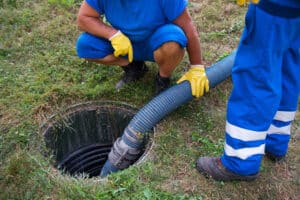Septic systems are a crucial component of rural and suburban home infrastructure, responsible for treating and disposing of household wastewater. However, the costs of installing or repairing a septic system can be substantial.
Thankfully, various programs offer financial assistance to homeowners looking to manage these expenses. We can tap into resources at the federal and state levels, including grants, loans, and other funding opportunities that can ease the financial burden.

Understanding the application process for a septic tank grant is the first step towards obtaining the needed financial support. These grants are typically available through environmental agencies or local health departments and are designed to help maintain public health and environmental standards. By equipping ourselves with knowledge about eligibility criteria, required documentation, and deadlines, we pave the way to a smoother application process.
Securing a grant often involves meeting specific conditions, such as household income limits or environmental impact considerations. Additionally, the property in question must usually be the applicant’s primary residence. By familiarizing ourselves with these requirements in advance, we can better prepare our applications and increase our chances of receiving assistance. It’s essential to compile all necessary paperwork, follow application guidelines, and submit before the specified cut-off dates to ensure a valid entry into these grant programs.
Understanding Septic Systems
In this section, we’ll explore the essentials of septic systems, including their basic components and the crucial role maintenance plays in safeguarding water treatment and groundwater quality.
Septic System Basics
A septic system is an onsite sewage facility commonly used in areas lacking centralized sewer systems. Septic tanks are the primary component, collecting and separating waste from water. Organics break down via anaerobic processes, while solids settle to the bottom. Liquid effluent then flows out into a drain field, undergoing further natural filtering before reaching the groundwater.
Components:
- Tank: Holds and separates waste.
- Drain field: Distributes liquid for soil filtration.
Function:
- Separation: Solid waste settles; scum rises.
- Treatment: Bacteria degrade organic material.
- Discharge: Treated water is released, minimizing water treatment needs.

Importance of Proper Maintenance
Regular maintenance of septic systems is crucial for operational efficiency and the protection of public health and the environment. A poorly maintained system can lead to system failure, costly repairs, and potential contamination of groundwater. We’re responsible for:
- Inspections: Conducting periodic assessments by professionals.
- Pumping: Removing accumulated solids from the tank to prevent system overloading.
Remember: Proactive maintenance prevents costly repairs and safeguards our water resources.
Eligibility Criteria for Grants
When seeking financial assistance for septic system projects, we must meet specific eligibility requirements. These criteria ensure that grants support homeowners effectively, promote environmental health, and allocate funds to the systems most in need of attention.
Homeowner Eligibility
To be eligible for a septic tank grant, homeowners must typically provide proof of property ownership and demonstrate that the septic system serves as their primary waste management solution. It’s essential to check with the relevant funding agency, as household income might also play a role in determining eligibility.
Location and Environmental Impact
Our property’s location significantly impacts our grant eligibility. Grants are often provided to properties in designated areas that require environmental protection. The Environmental Protection Agency supports projects that lead to pollution control, which includes repair or replacement of failed septic systems to prevent environmental degradation.
System Requirements and Conditions
Eligible systems may include those that need an upgrade for nutrient removal or a new installation to replace a failing system. Grant conditions typically stipulate that the system must comply with local health and safety regulations. Continued maintenance of the system may also be a factor in securing funding. For instance, establishing a Responsible Management Entity can help in managing permitting fees and ensuring regulatory compliance.
We must always confirm the specifics of the grant program we are applying to, as conditions and requirements vary by region and agency.
Finding Septic Tank Grants
When we seek financial assistance for septic system maintenance or installation, it’s important to know where to look. Federal and state-level programs are available offering grants and loans designed to support septic system projects, especially in rural areas.
Federal Funding Sources
U.S. Environmental Protection Agency (EPA):
The EPA provides states with grants under section 319 of the Clean Water Act. These grants aim to control nonpoint sources of pollution, which includes funding for the construction, upgrade, or repair of on-site septic systems. For example, these grants for septic systems provided by the EPA can be instrumental in improving water quality.
U.S. Department of Agriculture (USDA):
The USDA’s Water & Waste Disposal Loan & Grant Program is specifically tailored for residents in eligible rural areas. This initiative aims to supply clean drinking water and adequate sanitary sewage disposal. There’s also the provision to support septic systems through these projects, outlined in their Water & Waste Disposal Loan & Grant Program details.
State-Specific and Local Programs
Different states have tailored programs to meet the specific needs of their residents. It’s crucial to check with your local health or environmental departments to understand what is available in your area.
New York’s Environmental Facilities Corporation:
For instance, New York residents can benefit from the Septic System Replacement Fund, which reimburses homeowners for part of their septic project costs. You can find additional information on the Septic System Replacement Fund and check eligibility criteria.
Local health departments may also have information on community-specific grants or low-interest loan programs designed to aid residents in maintaining environmentally safe septic systems. Visit our Grants and Rebates page for more New York State and Suffolk County-specific funding resources.
By exploring these federal and state-specific resources, we can find financial assistance that aligns with our needs for septic system funding. Whether it’s grants to reduce pollution or loans to modernize rural infrastructure, these programs are designed to help maintain the health of our environment and communities.
Application Process for Grants
The application process for septic tank grants can seem complex, but we’ll guide you through the necessary steps and required documentation to enhance your chances of success.
How to Apply
To begin applying for a septic tank grant, first ensure you meet the eligibility criteria as specified by the grant provider. In many cases, this may relate to the location of your property, the condition of your existing septic system, and your financial circumstances. For federal grants, the US EPA offers a starting point to understand the available funding under the Clean Water Act. Likewise, the Rural Development section of the USDA outlines options for rural areas. You should:
- Visit the website of the grant provider.
- Locate their grant application portal or section.
- Follow their specific instructions for submitting an online or paper application.
Supporting Documents and Information
When you apply for a septic tank grant, you’ll need to collect various supporting documents to substantiate your application. These documents typically include:
- Proof of property ownership
- Current financial statements
- Estimates for septic system repair or replacement
- Inspection reports of your current septic system
It’s important to provide accurate and comprehensive information to avoid potential delays or rejections of your grant application. Guidelines provided by Government Septic Tank Grant can give you further insights into the application requirements. Remember, each grant provider has its own set of requirements and it’s crucial to tailor your application to these specifics.
Understanding Loan Options
When exploring options for financing a septic system, it’s crucial to understand the variety of loan opportunities available. We’ll outline two primary avenues: low-interest loans, including those offered by the United States Department of Agriculture (USDA), as well as specific grants like the Rural Decentralized Water Systems Grant.
Low-Interest Loans
United States Department of Agriculture (USDA): The USDA provides long-term, low-interest loans for rural homeowners. These loans can be used for water and waste disposal, which includes septic system upgrades or replacements. It’s important to check your eligibility, as these programs are designed for areas with populations of 10,000 or less.
Craft3: Homeowners in the states of Washington and Oregon can consider a non-profit lender such as Craft3, which offers environmental loans, including septic system financing. They offer loans aimed at repairing or replacing septic systems, supporting not only environmental well-being but also public health.
Rural Decentralized Water Systems Grant
The Environmental Protection Agency (EPA) also provides a source of funding through grants. The Rural Decentralized Water Systems Grant is tailored specifically for individual households, native tribes, and rural homeowners. This grant facilitates the installation or refurbishment of decentralized water systems, which encompass septic systems.
Understanding these options and selecting the right one can significantly alleviate the financial burden of septic system projects. We recommend due diligence in exploring these financial avenues to fund your septic system responsibly and sustainably.
Additional Financial Support

When seeking financial aid for septic system projects, it’s critical to look at tapping into both federal funding sources, local government funding, and nonprofit organizations dedicated to environmental health. Below, we detail some viable options for additional financial support that can complement grants you might be applying for.
Craft3 and Other Organizations
Consider alternative financing options such as those offered by Craft3, a nonprofit lender that provides loans for septic system repairs or replacements in certain regions. These loans can serve as essential supplements to grants. Organizations like this are dedicated to providing funding for environmentally responsible projects, ensuring septic systems meet regulatory standards and protect community health.
Craft3’s Septic Loan Program:
- Offers low-interest loans
- Is available in specific counties of the Pacific Northwest
Additionally, we can explore other regional organizations that provide similar financial assistance programs targeting septic system work, especially in rural or underserved areas.
EPA’s Water Finance Clearinghouse
The U.S. Environmental Protection Agency (EPA) also supports septic system funding through its Water Finance Clearinghouse. This resource is a one-stop-shop for our water infrastructure financing needs, where we can access:
- Database of Funding Sources: A comprehensive collection of water funding sources allows us to seek funds according to our specific needs.
- Resource Recovery Opportunities: Encourages efficient use of resources, helping our environmental impact.
The Clearinghouse is an invaluable source because it not only offers insights into feasible EPA grants but also guides us toward maintaining sustainable and cost-effective water systems.
Ensuring Compliance
When applying for a septic tank grant, it’s crucial to ensure that you’re complying with all of the rules and regulations outlined within the grant. This includes adhering to local permits, regulations, and water quality standards. Navigating these requirements is vital to secure funding and to protect environmental health.
Permits and Regulations
You must first obtain the necessary permits before any septic system work begins. Permits are typically issued by your local Department of Environmental Health or similar regulatory body. It is essential to check with them for specific requirements, as they can vary greatly by region.
The most basic steps in this process are:
- Submit a site plan for approval.
- Ensure the system’s design meets local health department specifications.
Adherence to these regulations not only protects you from legal issues but also ensures the longevity and proper functioning of the septic system.
Water Quality Standards
Your project must comply with the Water Quality Standards established by the Environmental Protection Agency (EPA). These standards are crucial to prevent pollution from nonpoint sources, including malfunctioning septic systems. The minimum standards of compliance would require:
- Ensuring your system doesn’t compromise the local water quality.
- Determine if the planned system aligns with EPA grants under section 319 of the Clean Water Act.
Meeting these standards confirms that our project contributes to environmental well-being and public health, which are often key criteria for grant approval.
Special Cases and Considerations

When applying for septic tank grants, it’s crucial to address specific situations such as failing systems in environmentally sensitive locations and the potential for utilizing innovative alternatives. Our focus here is on ensuring that we provide relevant information for these particular scenarios.
Failing Systems in Sensitive Areas
For septic systems failing in sensitive areas, such as near coastal waters (e.g. Long Island), we must recognize the urgency and potential for greater environmental impact. Failing septic systems can contaminate local ecosystems, making their replacement or repair a priority.
For instance, if your septic system is contributing to the degradation of coastal waters, it’s imperative to explore federal funding opportunities. These may include EPA programs that specifically address water quality issues related to septic systems.
Innovative and Alternative Solutions
When traditional septic systems are not viable, or if there’s a desire to enhance performance, innovative and alternative solutions may be considered. Some EPA programs offer grants that support these types of systems, especially when they provide environmental benefits such as reduced pollution or water conservation.
- Green Infrastructure Grants: Check for funding aimed at sustainable wastewater management solutions.
- Technology Advancement: Research whether your proposed innovative system qualifies for special funding based on its benefits.
New York State, Suffolk County, and individual townships on Long Island all have numerous grant and rebate programs available to help defray or eliminate the cost of these types of advanced septic treatment systems.
By understanding the specific conditions and applying for grants designed for such cases, we ensure the protection of our environment and the long-term sustainability of wastewater management systems.
After Receiving a Grant

Once you have successfully obtained a grant for your septic system project, it’s time to focus on two crucial phases: proper installation or replacement, and diligent ongoing maintenance. These steps ensure that our system functions efficiently and complies with environmental regulations.
Installation and Replacement
When installing a new septic system or replacing an old one, you must adhere to the specific guidelines provided by the grant. This often includes:
- Choosing Qualified Contractors: Selecting professionals who are licensed and experienced with septic system installation is crucial for the project’s success.
- Permit Process: Ensuring all the necessary permits are in place before beginning the installation or replacement, following local health department requirements.
Ongoing Maintenance and Monitoring
Maintaining your system involves regular inspection and upkeep:
- Regular Inspections: Conduct semi-annual or annual inspections to catch and correct issues early on.
- Pumping Schedule: Establishing a consistent schedule for pumping the septic tank, typically every 3-5 years, to prevent sludge buildup.
By keeping up with these tasks, you can extend the life of your septic system and ensure it operates efficiently. This proactive approach can prevent costly repairs and system failures.









